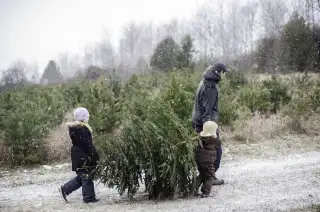5 Easy Ways to Get a Great Deal on Your Christmas Tree

While the tree is the centerpiece of most families' Christmas decor, overspending on something that will be thrown away in three to four weeks doesn't make much sense, especially in light of the staggering gift, food and travel costs that also need paying this time of year.
According to the National Christmas Tree Association, Americans spent more than $1 billion on fresh, farm-grown trees in 2014. The reported mean average price paid was around $40, but that can easily triple depending on the size and variety of the tree you pick and your location, or if you're one of the families who decorate more than one tree at holiday time.
Here are five easy ways you can score that perfect tree for the price of Charlie Brown's reject.
Cut Your Own
If you live near a wooded area, consider chopping down your own foliage. Check the USDA’s Forest Service website to see if there are any tree-cutting spots at a nearby national forest. Permits typically run between $4 and $15 (some places may charge an additional fee for the tree itself). Of course, the tradeoff for such a cheap tree is the extra time and effort it will take you to saw it down and cart it home—but it's an adventure!
Shop Wholesale
If you’d rather someone do the legwork for you, look for a Christmas tree wholesaler who also will sell to individuals. Wholesalers often operate their own lots, and some even offer online ordering of their trees. You save by cutting out the middleman. The Christmas Tree Farm Network has a directory of farmers by state across the country; some even offer online ordering.
Shop Around
If you're willing to take the time, you can do well by comparison shopping. Use the National Christmas Tree Association’s locator tool to find tree sellers in your area. “Each lot operates and prices differently,” says Rick Dungey, spokesman for the association. “I knew of one lot that gave a discount on Wednesdays since that was the slowest sale day, but it all depends on the individual seller.” Vendors also charge for trees differently: Some calculate the price by the foot, others charge a flat fee for any tree. Depending on the type and size of the tree you want, you may get a better deal going with one pricing method over the other. And while it may seem counter to the spirit of the holiday, feel free to haggle; sellers are often willing to negotiate.
Try a Different Species
There are dozens of types of Christmas trees you can choose from, each with its own unique features. Some, like the Noble fir, have superstrong branches that can hold your sturdiest ornaments. The Balsam fir gives off the sweetest scents, while the Fraser fir holds its needles the longest. Some species can be much more expensive, depending on popularity, growing time, and how far the trees had to be shipped. If you really want to save, skip the firs altogether and opt for the cheaper Scotch pine.
Wait for the Last Minute
The closer we get to Christmas, the cheaper you'll find a tree. The steepest discounts will start four or five days before the holiday. Of course, by then the selection will be much more limited, and you'll have less time to enjoy it. But if you're a family that traditionally decorates the tree on or close to Christmas Eve, then this method is best for you.
Before You Leave the Lot
Whatever tree you buy, there are two keys things you'll need to do before you leave the lot to make sure you've got a tree that will last the season:
Grab a tree branch and pull it through your hand, says Dungey. You want the green needles to still be firmly attached and for the branch to bend. "Look for pliability. If the branch snaps or seems brittle, it is already dried out," he says. "You can tell when a tree is past the point of no return, it is all snap, crackle, pop. But if you're unsure, just move on and buy another tree."
Have the lot make a fresh horizontal cut, about a quarter-inch to a half-inch wide, off the bottom of the tree stump. This will help the plant take in water and stay fresh longer. "You'll want to get the cut surface into water within three to six hours," says Dungey. "Too much air will get into the tree if it is left out longer, and it will inhibit its ability to absorb water."
Once You Get the Tree Home
The most important thing you can do to make sure the tree stays green is invest in a good tree stand—one that is stable, attaches to the tree, and holds plenty of water, ideally a gallon. "Even small trees can absorb a lot of water in a short time, and you want to make sure that the water level in the stand never gets below that fresh cut you had made," says Dungey.
You'll also want to be careful about where you set up the tree. Avoid placing it near any heat sources like vents, stoves, fans, or fireplaces. Hot blowing air will dry it out and make it brittle. You'll also want to avoid placing it in front of a window that gets a lot of sunlight, espeically one that faces south, says Dungey. "Sunlight and hot air will destroy your plant."